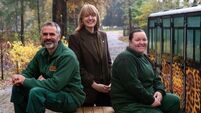Rose of Tralee a glimmer of hope in an Ireland where life is changing fast
Tralee is certainly not as bad as it was painted last Sunday, but it could be heading that way. Instead of addressing the problems, many people would rather complain about the media for highlighting them.
WHEN the Americans entered the Second World War following the attack on Pearl Harbor, they decided to send an intelligence agent to Ireland to find out what was happening on the ground. The agent, Robert R Patterson, had spent many years working for the American consulate in Cork and had only returned to the United States in 1940.
He visited this country again in January 1942 and travelled about the country for three weeks. He then wrote an alarming report in which he described Tralee as the “hot spot” of Nazi activity in Ireland.
Another agent was recruited to find out what was happening in Tralee, and he quickly rubbished the earlier report. Some time in the late 1950s Radio Éireann reported that there were some anti-Semitic slogans painted in Tralee.
In my neighbourhood some young lads painted a swastika on the walkway to the home of the late Jim Bailey, an English teacher. Under it they wrote “Death to all anti-Natzis (sic).”
It was nothing more than a schoolboys’ prank. Jim Bailey was amused that Radio Éireann could have taken the thing seriously when the culprits could not even spell “Nazis”.
Tralee seemed agog for much of this week over an article in the Sunday Independent about the town’s social problems. It reminded me of the earlier incidents.
Some of the Sunday Independent’s article was over the top. The article suggested that Tralee is more violent that rough parts of London and New York, and it compared the town with Weimar Germany around the time of the rise of Nazism. The Nazis are no more relevant to Tralee in 2009 than they were in 1942 or the late 1950s. Those aspects of the article, which were over the top, should be ignored, but we should be aware that we are developing distinct social problems throughout the country. Mayo sounded much worse that Kerry last week.
While in Washington DC doing research in the 1970s, I finished early one evening and decided to take a bus to New York rather than going through the hassle of trying to get to the airport on the chance of catching a flight. I asked at the National Archives for the location of the nearest bus station. When told it was only a quarter to a half a mile away, I asked if it would be safe to walk there, as it was still daylight.
The woman looked at me in horror and said she wouldn’t try it. So I took a taxi. The same thing happened about eight years ago in Dublin. I left a function before midnight on the north side, not far from Parnell Square. I asked if it was safe to walk down to O’Connell Street and got the kind of look and answer that I got in Washington.
In some respects we have aped the worst of America. Tralee is certainly not as bad as it was painted, but it could be heading that way. Instead of addressing the problems, many people would rather complain about the media for highlighting them.
Maybe people in Tralee have become touchy about criticism at this time of the year. For decades the media has been panning the Rose of Tralee.
The Rose selection has been broadcast live for 30 years. Gay Byrne was instrumental in persuading the authorities at RTÉ to broadcast the programme and he promptly received a Jacobs television award for his performance.
With him in the driving seat the programme developed into the strongest reminder of the importance of the Irish diaspora. We have tended to take them for granted.
Growing up I remember The Walton Programme on Radio Éireann with Leo Maguire saying in a lugubrious voice: “If you feel like singing, do sing an Irish song.” Yet he seemed to play some dreadful dirges.
From my perspective it was the Clancy Brothers and Tommy Makem who rescued Irish folk music from Leo Maguire. They made their names in the United States, and I readily understood why when I went there.
I could never hear enough of their records, or some of the other groups that followed, like the Dubliners and the Irish Rovers. They reminded me of home, but they seemed to be so much better than anything I ever heard in Leo Maguire’s day.
It was two Irish-Americans. Michael Flatley from Chicago and Jean Butler from New York, the original stars of Riverdance, who did so much to popularise Irish dancing on the international stage. This was a wake-up call that the Irish abroad and their descendants are a national asset to be treasured by the people of this country.
In reality that was part of the message Gay Byrne brought home in his presentation of the Rose of Tralee. The charm of the event was, as he said himself, that the contestants could be anybody’s daughter, sister or niece. It was not a beauty competition or a talent contest, but it did combine elements of each in what might be called a personality show. The winner was selected by the judges for possessing a kind elusive quality typified by the line in the song –“’twas not her beauty alone that won me.”
If some of critics had their way, the Rose of Tralee would not have lasted long on television. Over the years critics lambasted the show, but then they seemed conveniently oblivious when the ratings showed the programme was phenomenally popular with the viewing public.
“Irish newspapers are remarkably selective about what they decide to print or not to print in relation to RTÉ,” Gay Byrne wrote in his Sunday World column after the original show was televised in 1978. When RTÉ announced record audience figures, the press largely ignored it.
Gay Byrne and 29 girls “demeaned themselves by taking part in this preposterous circus,” Niall Fallon complained in 1981. “Is it not odd that women who seek to be equal to men should by taking part in the degrading charade of the Rose of Tralee contest, make nonsense of their own pleas to be taken seriously?”
BUT the Tam ratings indicated that 543,000 households were tuned into the programme, which was well in excess of the second-ranked programme, Flamingo Road, which had 409,000. The second highest rated home-produced programme had 374,000. By comparison, the highest rating any programme featuring the visit of Pope John Paul II to Ireland in September 1979 achieved was 488,000.
“Any television event which draws so large an adulatory audience is perforce an event of public importance and as such cannot just be ignored because some grouchy old critic doesn’t like it,” Fallon wrote. “But then it isn’t true that I don’t like it. I abominate it.
“I know I am in a minority,” Fallon admitted. “The Rose of Tralee is one of the year’s popular events on RTÉ, this year, even occupying the best part of two evenings prime viewing time. If that is a comment on the standard of public taste in Ireland so be it.” More likely it was a reflection of his own attitudes, because he seemed to be suggesting, in essence, that all those viewers lacked taste.














